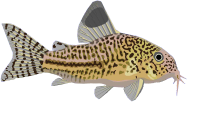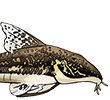Silurus wrote:I have narrowed it down to either O. mariae or O. vittatus. You need to count the number of non canal-bearing lateral plates that separate the anterior and posterior fields of canal-bearing plates (5 or less=mariae; 6 or more=vittatus), as well as the number of canal-bearing plates in the posterior field (9 or more=mariae; 8 or less=vittatus) in order to distinguish the two.
I also tried the key, and first got
vestitus, but after re-keying came to
vittatus/mariae. Which, as you say, are basically identical, and if one reads between the lines in Schaefer, it seems they may even be conspecific.
However, the pigmentation on the caudal fin, and especially the pigmentation anterior of the caudal fin, but below the lateral line, is similar (but stronger) in my fish and the
vittatus in the key, but dissimilar to the
mariae's two distinct W's. I'm also not sure I'd agree with the spines on the margin of the head being only "moderately" enlarged compared to the spines on the dorsal side of the head.
As you say a positive ID requires seeing the canal-bearing plates, and in these images they're obscured by the lateral pigment band. However, I *think* I can count 6 (or possibly 8) canal-bearing plates in the anterior part, and 5 in the posterior, which, again, suggests that it is a
vittatus.
Hence I provisionally consider my fish to be
Otocinclus vittatus!
(And probably a male!)
A heartfelt thanks for all the help!






